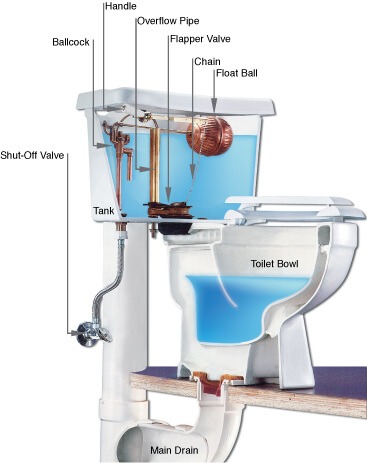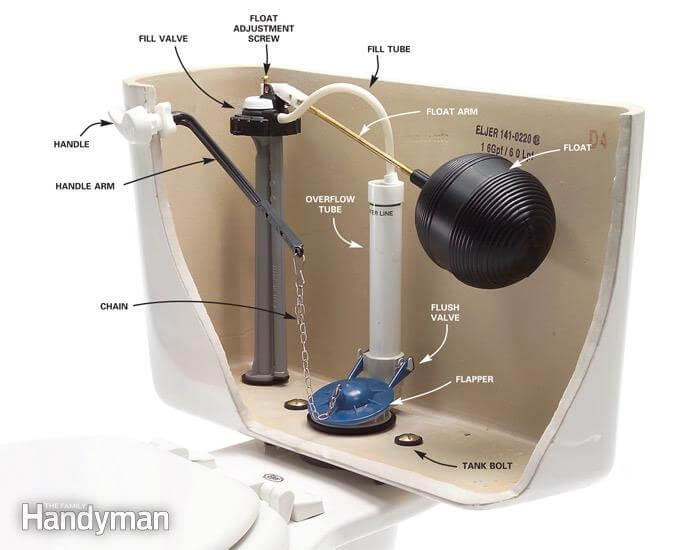
There are many of toilet repairs that are best handled by the pros, but there are a few things that any homeowner can do. This guide will go through some of the most common problems and show which ones you can do and which ones require professional help.
Some modern toilets come with an instruction manual. If your toilet has one, always check it and follow the recommendations.
Disclaimer: Please note that there are many reasons why a toilet may not be working, and these instructions don’t cover everything. As with any DIY attempt, you try these fixes at your own risk. If you want guaranteed results, hire a plumber.
How a Toilet Works
First, it will help a lot to understand what the parts of a toilet are and how they work. Not all toilets are exactly like the image below, but this is a pretty typical layout.

What Happens When You Flush a Toilet?
Toilets generally work like this:
- When you push the handle down, the chain lifts up the flapper.
- The tank full of water flows through the flush valve and down into the toilet bowl. This forces the contents of the bowl down through the trap and down the main drain (also called a soil stack).
- When the tank has fully emptied, the flapper closes. The fill valve allows water into the tank.
- Once the tank has filled, the float ball shuts off the water via the fill valve.
The toilet bowl always should have at least a bit of water in it. This not only makes flushing easier, but it seals out sewer gases that would otherwise enter your home through your main line.
Next, we’ll look at some common symptoms and help you troubleshoot the cause.
Common Toilet Problems and What to Do About Them
Toilet Handle Moves but There’s No Flush
Lift the lid off the top of the tank. Check the handle, handle arm, chain, and flapper.
- The chain may be out of adjustment, or may have even fallen off.
- The handle may have bent or may be broken.
- The nut that holds the handle on the tank may have come loose. If so, tighten gently with a wrench.
Toilet Won’t Stop Running
There are many potential causes – generally it means water is leaking out of the tank and into the bowl.
- The chain may have developed a kink or tangle that prevents the flapper from closing all the way.
- The flapper may no longer form a proper seal over the hole. Sometimes the rubbery material can harden or crack over time because of natural minerals in the water or chlorine in the water. If you use bowl cleaning tablets the chemicals in them can have a bad effect.
- If the flapper seems to fit well, then the problem may be in the fill valve. One thing can happen is white hard water scale that develops from minerals in the water.
Toilet Won’t Fill
The first thing to check is that the water supply valve behind the toilet is open (all the way to the right).
If you haven’t accidentally closed off the water supply, and you can still get water out of your taps, then the problem is in the tank.
Take a look at the float. Because it controls the water level in the tank, its position is important. Try adjusting the float adjustment screw a little higher and see if that works.
Some toilets have a fill line marked on the inside of the tank. If it doesn’t, a good rule of thumb is to fill it to about an inch below the top of the overflow tube.
If not, we recommend calling a professional.
Toilet Won’t Flush, or Won’t Flush All the Way
Clogs
You may have a clog or partial clog. If you have small children in the house, they may have tried some experiments with flushing toys that didn’t quite work out (we’ve removed some pretty silly things from toilets over the years). If you have house guests they may have tried to flush paper towels, feminine hygiene products, “flushable” wipes (we don’t consider these flushable), or simply too much toilet paper.
Our first step is to try plunging the toilet with a plunger. To reduce splashing and to get as much suction as possible, get a good-sized plunger and wiggle it into place so it entirely covers the hole at the bottom of the bowl. You don’t have to push quickly, just thoroughly.
If that doesn’t work, you can try using a snake from a hardware store, but it’s probably better to call a plumber to ensure the issue is resolved without damaging the toilet.
Other Issues
If the tank doesn’t have enough water in it, it won’t flush it. Try the steps in the “Toilet Won’t Fill” section above.
Water on the Floor Around the Toilet
Assuming no one has “missed the target”, it generally means one way or another the issue is serious and usually requires a professional. Two most common causes include:
- The wax seal between the bottom of the toilet and the main drain has come loose. Often the toilet will leak only when you flush.
- There is a crack somewhere in the base of the toilet. This is often the case when the leak is constant, even if you don’t flush.
Either way, it required immediate attention.
Water on the Sides of the Toilet Tank
This is called condensation, and it’s just like the water that collects on the outside of a cold glass on a hot summer day. If it’s a rare occurrence it’s not a problem, but if it happens regularly the condensation can run down the toilet and ruin your floor.
It means that your home’s air is warmer that the cold water in the toilet. Generally the solution is to get a dehumidifier, or if you have an air conditioner it may mean it’s not working properly.
If you don’t want to adjust your home’s air, you can also have a tank insulation kit installed.
When in Doubt, Get Help
Most toilets are fairly simple machines, and simple problems can be easy to fix. But we urge you to use common sense, and get help if you’re out of your depth. The last thing you want is to cause expensive water damage to your home.
Want to learn more about taking care of your plumbing? Our handy guide to preventing drain clogs will help you keep your water flowing the way it should.



